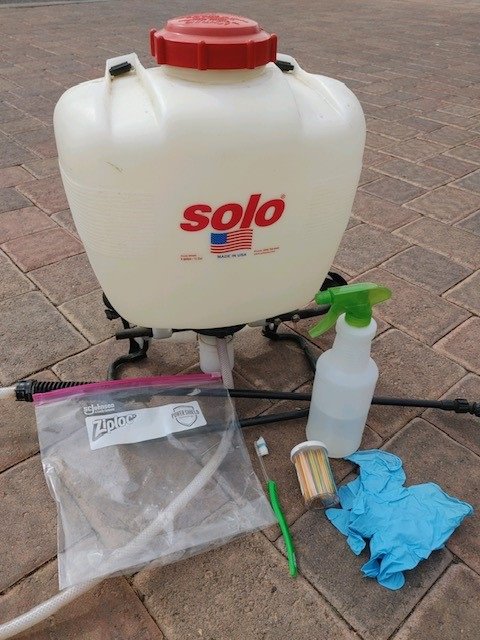
Photo by: Kit Galvin
 Take note
Take note
The applicator carries a resealable bag with the tools needed to unclog a nozzle. To keep their hands free, they can fasten the bag to their sprayer with a big binder clip or put it on a nearby bench.
 Idea...
Idea...
“I wanted to make it easier for me to clean and unclog the nozzle. I know blowing into the nozzles is not safe. I thought if I have all the supplies with me then I can take care of the problem right there. Now if I have a clogged nozzle, I can clean it safely and quickly.”
 Setup & use
Setup & use
Setup
- Place your supplies in a resealable bag.
- Attach the resealable bag to the backpack sprayer with a binder clip, or place it on a nearby bench.
Use
- Remove nozzle from spray wand.
- Use the tools to remove material clogging the nozzle.
- Spray bottle water stream to clear away dirt and debris.
- Toothpick to clean the nozzle orifice.
- Toothbrush to clean the screen.
- Rinse nozzle parts using spray bottle
- Reassemble the nozzle
- Put supplies back into the bag and seal
Cleanup
- Decontaminate supplies and resealable bag after completing the spray session.
- Air dry the supplies and bag.
- Put dry supplies in the clean bag.
- Replace supplies as needed.
 Supplies
Supplies
- Resealable 1 gallon plastic bag
- Toothpick
- Toothbrush
- Small spray bottle with water
- Single use chemical resistant gloves
- Spare nozzle
 Alert
Alert
Use the water stream from the spray bottle to remove dirt and debris from the nozzle. REMEMBER to never blow on the nozzle as you may get pesticides on your lips.

We hope that you will be inspired you to incorporate solutions into your own training style, develop your own hands-on teaching tools, or discover new practical solutions. We hope that you are inspired to use these solutions in your workplace. Did you try one of the practical solutions or develop a new one? We would appreciate hearing about your ideas and experiences.
Thank you and safe pesticide handling,
PNASH
Contact your state agency for more information on WPS regulations. The content of this website is for informational purposes only. It may need modification to fit your needs or it may not be appropriate for your workplace. Safe use of these solutions is your responsibility. The University of Washington and the Pacific Northwest Agricultural Safety & Health Center is not responsible for any loss or damage resulting from the use of the information provided on this website.
PNASH Project 2016-2021 (CDC/NIOSH Cooperative Agreement # U54 OH007544)
Contact us
Project Email:
PractSol@uw.edu
Project staff:
Maria Tchong-French (habla español)
206 685-6728
